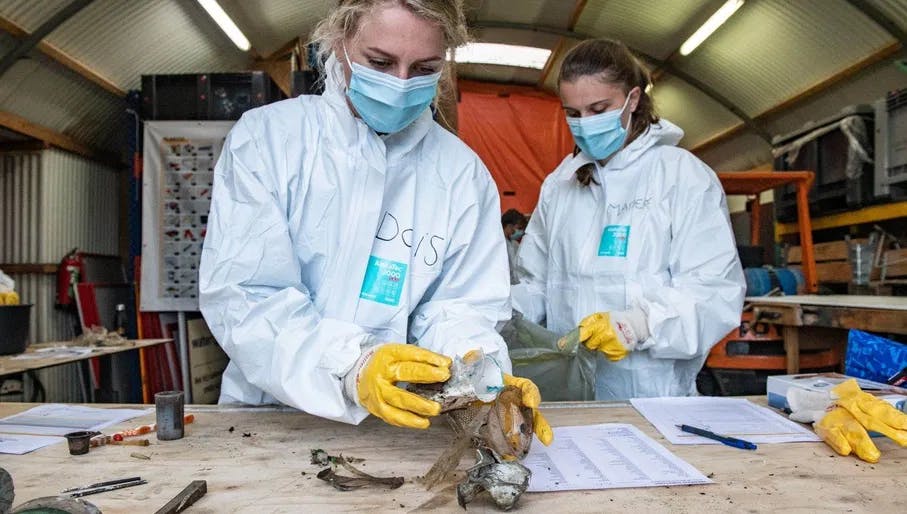
The Great Bubble Barrier protects oceans from plastic pollution
A simple solution to plastic pollution
At Westerdok in Amsterdam, close to central station, and where the canal exits to the IJ river, eagle-eyed passers-by will see a ripple running diagonally across the water. This is the world’s first bubble curtain to capture plastic pollution, the keystone technology developed by Amsterdam cleantech startup, The Great Bubble Barrier.
It’s a simple idea that can dramatically reduce the amount of plastic ending up in our oceans. Air is pumped through a perforated tube running along the bottom of the waterway, which creates an upward current that directs plastic to the surface. Following the natural flow of the water, the plastic then is guided to a catchment system. The bubble barrier targets the full width and depth of the water and allows marine life and ship traffic to pass through unhindered.
Like many great ideas in history, the concept was conceived up at a bar. Long-time friends, now co-founders, Francis Zoet, Anne Marieke Eveleens and Saskia Studer, were talking about plastic pollution when the bubbles in their glasses sparked a theory. Together with Philip Ehrhorn, who was also looking into the idea, the company was founded. The first full-scale pilot of the bubble curtain launched in the River IJssel in 2019. Franci Zoet tells I amsterdam:

“That was more successful than we had dreamed. After that, we were looking for a longer term pilot and the city of Amsterdam was very willing to give it a go, especially because of the high waste load in the city. We're very happy that Amsterdam took this first step. They are very happy that they will catch plastic in our canals, and, with other parties, it has been a very good starting point to see it in action and see that this is what we can do to remove plastic from our rivers.”
The Great Bubble Barrier now has 3 more projects currently operational and capturing plastic: two in the Netherlands, one exiting at the North Sea and another exiting at the UNESCO-protected Wadden Sea and a Bubble Barrier in the Porto region, Portugal, to stop plastic entering the Atlantic Ocean. Backed by the EU, the project also includes ecological monitoring to gather new insights about plastic in waterways. The team is rapidly expanding to more rivers in Europe, America, and Asia.
Supporting plastic policy
The Great Bubble Barrier also monitors its catch to help develop policy for plastic waste management, so that cities can implement solutions to clear up waterways, as they do streets. Francis says that while cities and citizens are eager to take action, there is a gap in policy and budget to address the issue.

"In the Netherlands, municipalities are responsible for litter on the streets, and water management boards are responsible for micropollutants and water quality in general, but that excludes macro pollutants like plastic and bigger waste objects. Rijkswaterstaat, the national water authority, is responsible for the 5 main rivers and their water quality. So there's still a big gap when it comes to the responsibility of plastic pollution in rivers".
Francis goes on the mention, "While cities have budgets for removing litter in the streets, they don't have budgets to remove waste from waterways. The cost of a Bubble Barrier can be compared to the cost of getting a new waste truck. Fortunately, some budgets for city innovation exist, which is what cities can use to clean their rivers".
An innovative city for startups
As an already booming startup and scaleup hub, the Amsterdam Area has a high density of connected companies, universities and research institutes which often collaborate. Buoyed by the Amsterdam Startup in Residence programme, which links startups to urban and social issues, The Great Bubble Barrier also credits its success to the city’s reputation for innovation.
“The City of Amsterdam, with their approach towards innovation, has really helped us to gain momentum. Also because they have quite a good reputation internationally around technology, that has in turn supported The Great Bubble Barrier. On top of that Amsterdam is part of the [WWF’s] Plastic Smart Cities programme, which means they are consciously investing in solutions to prevent plastic pollution and to make the city smarter in terms of plastic management".
“Our first long-term implementation in Amsterdam has helped bring The Great Bubble Barrier to the public eye. It's a simple concept, and we often get asked why it isn't deployed everywhere. When citizens and passersby visit the Bubble Barrier in Amsterdam in real life, it sends a message of hope for cleaner water. We look forward to cleaning more Amsterdam canals and setting an example of what smart cities could look like in the future."
Related articles

Climate Cleanup: scaling nature-based solutions to avert climate catastrophe

Schneider Electric: the world’s most sustainable company

Photanol is turning CO2 into circular chemicals

Amsterdam’s top energy startups to watch in 2024

Where are they now: decommissioning old wind-turbines

Powering the future: Amsterdam’s rise as a renewable energy hub

Watermeln’s green hydrogen generator is electrifying the future

What’s the hype around hydrogen?

Key facts and figures on Amsterdam’s energy sector



